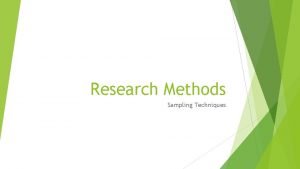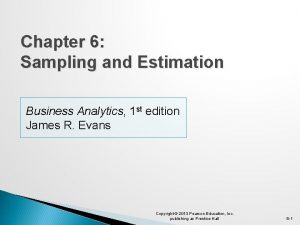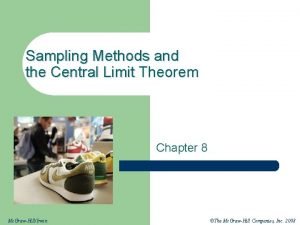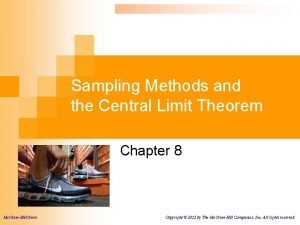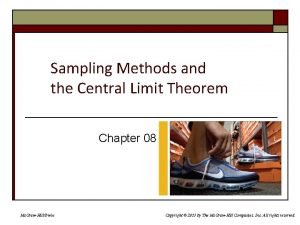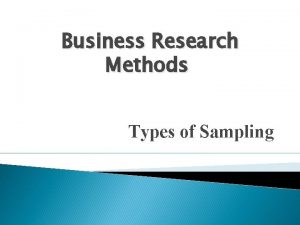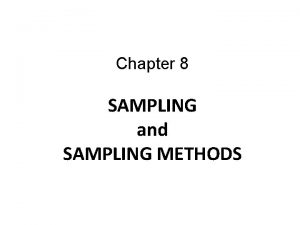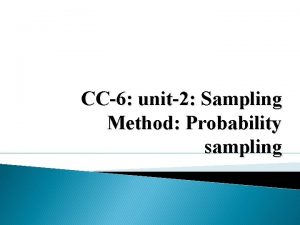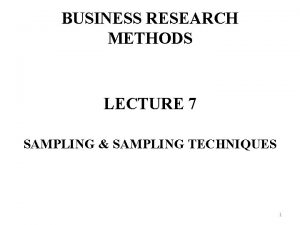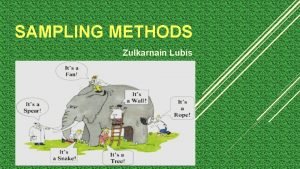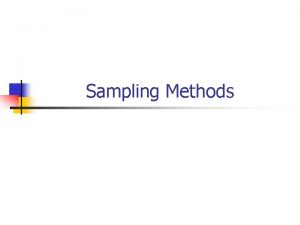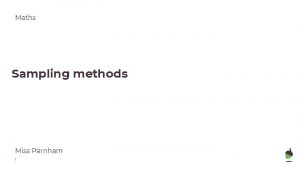RESEARCH METHODS LECTURE 7 Sampling Sampling is concerned










- Slides: 10

RESEARCH METHODS LECTURE 7

Sampling �Sampling is concerned with the selection of a subset of individuals from within a statistical population to estimate characteristics of the whole population. �Each observation measures one or more properties (such as weight, location, color) of observable bodies distinguished as independent objects or individuals.

Sampling Techniques �Probability sampling is one in which every unit in the population has a chance (greater than zero) of being selected in the sample, and this probability can be accurately determined. �The combination of these traits makes it possible to produce unbiased estimates of population totals, by weighting sampled units according to their probability of selection. �Probability sampling includes: Simple Random Sampling, Systematic Sampling,

�Non-probability sampling is any sampling method where some elements of the population have no chance of selection (these are sometimes referred to as 'out of coverage or where the probability of selection can't be accurately determined. �It involves the selection of elements based on assumptions regarding the population of interest, which forms the criteria for selection. �Hence, because the selection of elements is nonrandom, non-probability sampling does not allow the estimation of sampling errors. These conditions give rise to bias, placing limits on how much information a sample can provide about the

�Example: �We visit every household in a given street, and interview the first person to answer the door. In any household with more than one occupant, this is a non-probability sample, because some people are more likely to answer the door (e. g. an unemployed person who spends most of their time at home is more likely to answer than an employed housemate who might be at work when the interviewer calls) and it's not practical to calculate these probabilities. �Non-probability sampling methods include accidental sampling, quota sampling and purposive sampling.

Observation; Sampling Technique � Since it is usually impossible to observe behaviour for extended period of time because of fatigue and boredom one must plan how and when to make the observation. The most commonly used techniques are: � Time Sampling Method: � This procedure involves the selection of time periods during which the observation will take place. � � One decides the day into units that are appropriate for observation. The time frame may be systematically selected e. g. one can observe intermittently at 10 minutes interval for 8 hours a day or intermittent instantaneous observation may be carried out at 10 minutes interval for 24 hours. � Time frames can be selected at random. Here it is important that the researcher uses some system of signal when the observer should start looking and when to stop. Duration of observation should be decided before hand.

�Event Sampling: �When we want to observe an entire event in order to give the subject the opportunity to perform all of the expected behaviors. �The observer selects integral behaviour or event of a pre-specified type of observation. �Researcher either requires to know the occurrence of event or be in a position to wait for their occurrence e. g. a researcher observed aseptic practices in urinary catheterization where she observed the full procedure against the steps listed under different areas of procedure e. g. washing and drying hands, wearing gloves, etc. She carried out observation in surgical ward, surgical O. P. D. , casualty department.

Focus group; �Focus group is a form of qualitative research in which a group of people are asked about their perceptions, opinions, beliefs, and attitudes towards a product, service, concept, advertisement, idea, or packaging. �Questions are asked in an interactive group setting where participants are free to talk with other group members.

�Interviewing �An interview is where the researcher speaks to the respondent directly, asking questions and recording answers. Interviews are particularly helpful in gathering �data when dealing with complex and/or sensitive issues, and when open-ended questions are used to collect data. �Interviews also enable the researcher to obtain feedback and to use visual aids if the interviews are face to face. For example, respondents might be shown a new corporate logo, a new corporate mission statement, building designs, automobile styles and colours, and so on, and asked to comment. �Finally, interviews are flexible as to where they can be conducted (at work, home, or in malls, etc. ) and researchers can increase participation rates

THANK YOU.
 Https://slidetodoc.com
Https://slidetodoc.com Sampling techniques in qualitative research
Sampling techniques in qualitative research What is the sample size in qualitative research?
What is the sample size in qualitative research? 01:640:244 lecture notes - lecture 15: plat, idah, farad
01:640:244 lecture notes - lecture 15: plat, idah, farad Fabrication of wax pattern
Fabrication of wax pattern Sampling techniques psychology
Sampling techniques psychology Sampling and estimation methods in business analytics
Sampling and estimation methods in business analytics Aracr
Aracr Sampling methods and the central limit theorem
Sampling methods and the central limit theorem Sampling methods and the central limit theorem
Sampling methods and the central limit theorem Sampling methods and the central limit theorem
Sampling methods and the central limit theorem





